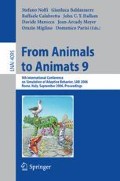Abstract
In this paper we present a novel information-theoretic measure of spatiotemporal coordination in a modular robotic system, and use it as a fitness function in evolving the system. This approach exemplifies a new methodology formalizing co-evolution in multi-agent adaptive systems: information-driven evolutionary design. The methodology attempts to link together different aspects of information transfer involved in adaptive systems, and suggests to approximate direct task-specific fitness functions with intrinsic selection pressures. In particular, the information-theoretic measure of coordination employed in this work estimates the generalized correlation entropy K 2 and the generalized excess entropy E 2 computed over a multivariate time series of actuators’ states. The simulated modular robotic system evolved according to the new measure exhibits regular locomotion and performs well in challenging terrains.
Access this chapter
Tax calculation will be finalised at checkout
Purchases are for personal use only
Preview
Unable to display preview. Download preview PDF.
References
Baldassarre, G., Parisi, D., Nolfi, S.: Measuring coordination as entropy decrease in groups of linked simulated robots (preprint, 2005)
Boffetta, G., Cencini, M., Falcioni, M., Vulpiani, A.: Predictability: a way to characterize complexity. Physics Reports 356, 367–474 (2002)
Bojinov, H., Casal, A., Hogg, T.: Multiagent control of self-reconfigurable robots. Artificial Intelligence 142, 99–120 (2002)
Carretero-González, R., Ørstavik, S., Stark, J.: Quasidiagonal approach to the estimation of lyapunov spectra for spatiotemporal systems from multivariate time series. Phys. Rev. E. Stat. Phys. Plasmas Fluids Relat. Interdiscip. Topics 62(5), 6429–6439 (2000)
Crutchfield, J.P., Feldman, D.P.: Regularities unseen, randomness observed: The entropy convergence hierarchy. Chaos 15, 25–54 (2003)
Der, R., Steinmetz, U., Pasemann, F.: Homeokinesis - a new principle to back up evolution with learning. In: Computat. Intelligence for Modelling, Control, and Automation. Concurrent Systems Engineering Series, vol. 55, pp. 43–47 (1999)
Dorigo, M.: Swarm-bot: An experiment in swarm robotics. In: Arabshahi, P., Martinoli, A. (eds.) Proceedings of SIS 2005 – 2005 IEEE Swarm Intelligence Symposium, pp. 192–200. IEEE Press, Los Alamitos (2005)
Feldman, D.P., Crutchfield, J.P.: Structural information in two-dimensional patterns: Entropy convergence and excess entropy. Physical Review E. 67, 051104 (2003)
Foreman, M., Prokopenko, M., Wang, P.: Phase Transitions in Self-Organising Sensor Networks. In: Banzhaf, W., Ziegler, J., Christaller, T., Dittrich, P., Kim, J.T. (eds.) ECAL 2003. LNCS (LNAI), vol. 2801, pp. 781–791. Springer, Heidelberg (2003)
Grassberger, P., Procaccia, I.: Estimation of the kolmogorov entropy from a chaotic signal. Phys. Review A. 28(4), 2591 (1983)
Klyubin, A.S., Polani, D., Nehaniv, C.L.: Organization of the information flow in the perception-action loop of evolved agents. In: Proceedings of 2004 NASA/DoD Conference on Evolvable Hardware, pp. 177–180. IEEE Computer Society, Los Alamitos (2004)
Klyubin, A.S., Polani, D., Nehaniv, C.L.: All Else Being Equal Be Empowered. In: Capcarrère, M.S., Freitas, A.A., Bentley, P.J., Johnson, C.G., Timmis, J. (eds.) ECAL 2005. LNCS, vol. 3630, pp. 744–753. Springer, Heidelberg (2005)
Kolmogorov, A.N.: Entropy per unit time as a metric invariant of automorphisms. Doklady Akademii Nauk SSSR 124, 754–755 (1959)
Prokopenko, M., Gerasimov, G., Tanev, I.: Measuring spatiotemporal coordination in a modular robotic system. In: Rocha, L.M., Bedau, M., Floreano, D., Goldstone, R., Vespignani, A., Yaeger, L. (eds.) Proceedings of Artificial Life X (in press, 2006)
Prokopenko, M., Wang, P., Foreman, M., Valencia, P., Price, D., Poulton, G.: On connectivity of reconfigurable impact networks in ageless aerospace vehicles. Robotics and Autonomous Systems 53, 36–58 (2005)
Prokopenko, M., Wang, P., Price, D.: Complexity metrics for self-monitoring impact sensing networks. In: Lohn, J., Gwaltney, D., Hornby, G., Zebulum, R., Keymeulen, D., Stoica, A. (eds.) Proceedings of 2005 NASA/DoD Conference on Evolvable Hardware (EH 2005), pp. 239–246. IEEE Computer Society, Los Alamitos (2005)
Prokopenko, M., Wang, P., Valencia, P., Price, D., Foreman, M., Farmer, A.: Self-organizing hierarchies in sensor and communication networks. Artificial Life 11, 407–426 (2005)
Rényi, A.: Probability theory. North-Holland, Amsterdam (1970)
Solé, R.V., Valverde, S.: Information theory of complex networks: On evolution and architectural constraints. In: Ben-Naim, E., Frauenfelder, H., Toroczkai, Z. (eds.) Complex Networks. Lecture Notes in Physics, vol. 650, pp. 189–210. Springer, Heidelberg (2004)
Takens, F.: Detecting strange attractors in turbulence. Dynamical systems and turbulence 898, 366 (1981)
Tanev, I.: Learned mutation strategies in genetic programming for evolution and adaptation of simulated snakebot. In: Genetic Evolutionary Computation - Gecco 2005, Proc., pp. 687–694 (2005)
Tanev, I., Ray, T., Buller, A.: Automated evolutionary design, robustness, and adaptation of sidewinding locomotion of a simulated snake-like robot. IEEE Transactions On Robotics 21, 632–645 (2005)
Theiler, J.: Spurious dimension from correlation algorithms applied to limited time-series data. Physical Review A. 34(3), 2427–2432 (1986)
Wang, P., Prokopenko, M.: Evolvable recovery membranes in self-monitoring aerospace vehicles. In: Schaal, S., Ijspeert, A., Billard, A., Vijayakumar, S., Hallam, J., Meyer, J.-A. (eds.) From Animals to Animats VIII - Proceedings of the 8th International Conference on the Simulation of Adaptive Behaviour, Los Angeles, pp. 509–518. A Bradford Book/MIT Press (2004)
Wuensche, A.: Classifying cellular automata automatically: Finding gliders, filtering, and relating space-time patterns, attractor basins, and the z parameter. Complexity 4(3), 47–66 (1999)
Yim, M., Roufas, K., Duff, D., Zhang, Y., Eldershaw, C., Homans, S.: Modular reconfigurable robots in space applications. Autonomous Robots 14, 225–237 (2003)
Author information
Authors and Affiliations
Editor information
Editors and Affiliations
Rights and permissions
Copyright information
© 2006 Springer-Verlag Berlin Heidelberg
About this paper
Cite this paper
Prokopenko, M., Gerasimov, V., Tanev, I. (2006). Evolving Spatiotemporal Coordination in a Modular Robotic System. In: Nolfi, S., et al. From Animals to Animats 9. SAB 2006. Lecture Notes in Computer Science(), vol 4095. Springer, Berlin, Heidelberg. https://doi.org/10.1007/11840541_46
Download citation
DOI: https://doi.org/10.1007/11840541_46
Publisher Name: Springer, Berlin, Heidelberg
Print ISBN: 978-3-540-38608-7
Online ISBN: 978-3-540-38615-5
eBook Packages: Computer ScienceComputer Science (R0)

